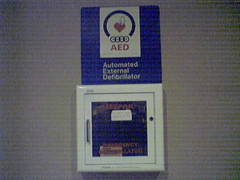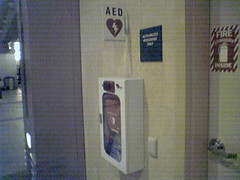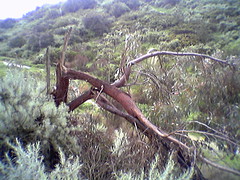
Friday, February 25, 2005
Wednesday, February 23, 2005
Monday, February 21, 2005
Sunday, February 20, 2005
Friday, February 18, 2005
Wednesday, February 16, 2005
The Mars Project
This is the first chapter of a DVD project I'm working on for fun. The title screen plays for a bit at the beginning. You don't have to click on anything to start the movie. The music is very low to begin. This is not an accident. This is how this particular piece of music is written and performed. Set your speaker volume at a normal level before starting the movie.
I hope you enjoy it as much as I enjoyed working on it.
See if you can guess which planet is next in the project.
Medium Resolution
High Resolution
I hope you enjoy it as much as I enjoyed working on it.
See if you can guess which planet is next in the project.
Medium Resolution
High Resolution
Monday, February 14, 2005
Saturday, February 12, 2005
Commentary for the Hymn "Tis Good Lord to be Here"
778 ‘Tis Good, Lord, to Be Here (Podcasting Project Draft)
This hymn is number 778 in our green gather hymnals. The tune often given to go with this hymn is "Potsdam" by Johann S. Bach, 1750. The notes in our hymnal say the tune is SWABIA, written by Johann M. Spiess, 1715-1772, and was then adapted by William Havergal.
If you are a German language speaker, you may have noticed that the pronunciation of Spiess that I am using follows the i-e spelling rather than the e-i spelling that is in the notes of this hymn. It appears that the spelling of Johann M. Spiess in our hymnal might be a misprint, judging by how many other citations out there use the Spiess spelling rather than the Speiss spelling.
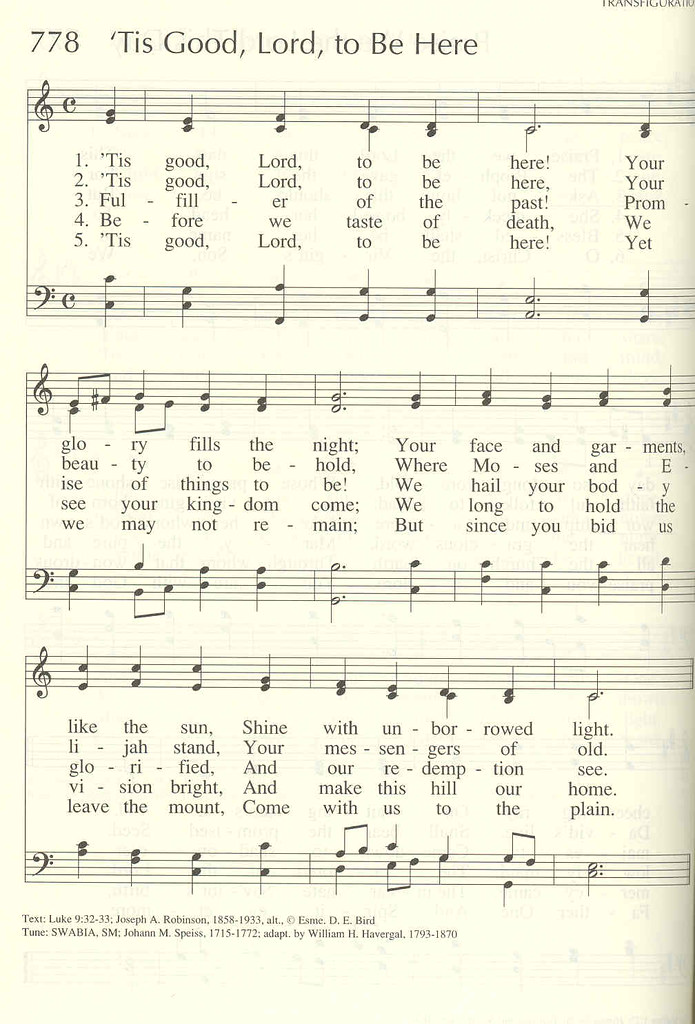
The first order of business is to look at the three tunes to see how similar they are.
Here is what Potsdam sounds like. This file was created from a midi prepared by R. Jordan. It’s in the key of E Major.
potsdam
Here is the tune called Swabia. R. Jordan sequenced this version in midi. It’s in the key of D Major. The name Swabia is from the German Schwaben, which is a historic region of southwestern Germany. It includes what is now the southern portion of Baden-Württemberg and the southwestern part of Bavaria in Germany, as well as eastern Switzerland and Alsace.
Swabia's name is derived from that of the Suebi, a Germanic people who, with the Alemanni, occupied the upper Rhine and upper Danube region in the 3rd century.
swabia
And finally, here is the tune for Tis Good, Lord, to Be Here, from our green gather hymnal. It’s in the key of C Major and was also sequenced by R. Jordan. This is the adaptation of Swabia by William H. Havergal.
All voices
You should be able to hear the similarities of all three songs and how the hymn works within the meter of the tune.
The biblical passage from which this hymn is based is Luke chapter nine verses 32 – 33. I’m going to read verses 28 through 45. This is the story of the transfiguration.
The Transfiguration
28 Some eight days after these sayings, He took along Peter and John and James, and went up on the mountain to pray.
29 And while He was praying, the appearance of His face became different, and His clothing became white and gleaming.
30 And behold, two men were talking with Him; and they were Moses and Elijah,
31 who, appearing in glory, were speaking of His departure which He was about to accomplish at Jerusalem.
32 Now Peter and his companions had been overcome with sleep; but when they were fully awake, they saw His glory and the two men standing with Him.
33 And as these were leaving Him, Peter said to Jesus, "Master, it is good for us to be here; let us make three tabernacles: one for You, and one for Moses, and one for Elijah" -- not realizing what he was saying.
34 While he was saying this, a cloud formed and began to overshadow them; and they were afraid as they entered the cloud.
35 Then a voice came out of the cloud, saying, "This is My Son, My Chosen One; listen to Him!"
36 And when the voice had spoken, Jesus was found alone. And they kept silent, and reported to no one in those days any of the things which they had seen.
37 On the next day, when they came down from the mountain, a large crowd met Him.
38 And a man from the crowd shouted, saying, "Teacher, I beg You to look at my son, for he is my only boy,
39 and a spirit seizes him, and he suddenly screams, and it throws him into a convulsion with foaming at the mouth; and only with difficulty does it leave him, mauling him as it leaves.
40 "I begged Your disciples to cast it out, and they could not."
41 And Jesus answered and said, "You unbelieving and perverted generation, how long shall I be with you and put up with you? Bring your son here."
42 While he was still approaching, the demon slammed him to the ground and threw him into a convulsion. But Jesus rebuked the unclean spirit, and healed the boy and gave him back to his father.
43 And they were all amazed at the greatness of God But while everyone was marveling at all that He was doing, He said to His disciples,
44 "Let these words sink into your ears; for the Son of Man is going to be delivered into the hands of men."
45 But they did not understand this statement, and it was concealed from them so that they would not perceive it; and they were afraid to ask Him about this statement.
Joseph A. Robinson was born 1858 and died 1933. He therefore lived and worked later than either Bach, who wrote Potsdam in 1750, or Johann Spiess, who wrote Swabia in 1745.
Robinson took these biblical verses from Luke and wrote the words that appear in this song in our hymnal. There is a note in our hymnal that the tune was adapted by William H. Havergal, who lived from 1793 to 1870. The Havergal arrangement of Swabia is also used by Isaac Watts in a hymn called Behold What Wondrous Grace.
Here are the words to the hymn. The realization and the celebration of the transfiguration are captured by these verses.
1. 'Tis good, Lord, to be here,
Thy glory fills the night;
Thy face and garments, like the sun,
Shine with unborrowed light.
2. 'Tis good, Lord, to be here,
Thy beauty to behold
Where Moses and Elijah stand,
Thy messengers of old.
3. Fulfiller of the past,
Promise of things to be,
We hail Thy body glorified
And our redemption see.
4. Before we taste of death,
We see Thy kingdom come;
We fain would hold the vision bright
And make this hill our home.
5. 'Tis good, Lord, to be here.
Yet we may not remain;
But since Thou bidst us leave the mount,
Come with us to the plain.
Of course, our hymnal replaces the word thy with your and the word fain with long, but other than that the words to the hymn are original to Robinson. The themes of the transfiguration, the hint of things to come, redemption, and the desire that if we cannot stay upon the mountain then at least have Jesus come with us to the plain below are images from Luke that are brought to life by this hymn.
Let’s look at the parts of the piece. The soprano line starts on G5. G5 and C5 as well as C6 are the prominent or milestone notes. Here is the soprano part.
Soprano
The alto part provides a bit of closure in measure three when the alto note coincides with the soprano for the dotted half note at C5. The alto part provides the second half of the eighth-note movement in measure four, which provides for a feeling of movement in the piece without burdening any one line with too many eighth-notes. Everyone shares in these eighth-notes, with the tenor part getting all of theirs in the last measure and the bass part having two separate eighth-note parts. The soprano and alto parts are right by each other in measure four. Measure six and seven for all parts, but perhaps especially the alto part, provide a solid rhythm that anchors the eighth-note sections of measure eight.
alto
The tenor part has a more difficult first half. The B4 note of the second beat in measure four and the first three beats of measure five are possibly the most tricky notes to hit. The first B4 is important because it provides a base for the middle of the eighth-note passage that the sopranos and altos are doing. With both of the upper parts moving relatively quickly compared to the tenor part, it might be a challenging note. The second B4 note, the dotted half note in measure five, is important because it’s being held three beats. The last two beats of the tenor line are fun, since they swoop down to E4. Here is the tenor line.
tenor
The first key note for the bass line is the dotted half note that begins measure three. It’s counterintuitive, at least to me, and since it’s held for three beats, and since it anchors the beginning of the eighth-note movement in measure four and well as supporting a key melodic note sung by the soprano line, it needs to be strong and true. The dotted half note that starts measure five might feel much more natural. This is a good thing, because the last half of the bass line is challenging. The first note of measure seven is A4, which is pretty high. The line drops down an octave in the last two beats of measure eight, from G4 to G3, then up to C4 to resolve the final chord.
Putting all the parts together for one final listen. Here is Tis Good, Lord, to Be Here, number 778 in our green gather hymnal.
all voices
This hymn is number 778 in our green gather hymnals. The tune often given to go with this hymn is "Potsdam" by Johann S. Bach, 1750. The notes in our hymnal say the tune is SWABIA, written by Johann M. Spiess, 1715-1772, and was then adapted by William Havergal.
If you are a German language speaker, you may have noticed that the pronunciation of Spiess that I am using follows the i-e spelling rather than the e-i spelling that is in the notes of this hymn. It appears that the spelling of Johann M. Spiess in our hymnal might be a misprint, judging by how many other citations out there use the Spiess spelling rather than the Speiss spelling.

The first order of business is to look at the three tunes to see how similar they are.
Here is what Potsdam sounds like. This file was created from a midi prepared by R. Jordan. It’s in the key of E Major.
potsdam
Here is the tune called Swabia. R. Jordan sequenced this version in midi. It’s in the key of D Major. The name Swabia is from the German Schwaben, which is a historic region of southwestern Germany. It includes what is now the southern portion of Baden-Württemberg and the southwestern part of Bavaria in Germany, as well as eastern Switzerland and Alsace.
Swabia's name is derived from that of the Suebi, a Germanic people who, with the Alemanni, occupied the upper Rhine and upper Danube region in the 3rd century.
swabia
And finally, here is the tune for Tis Good, Lord, to Be Here, from our green gather hymnal. It’s in the key of C Major and was also sequenced by R. Jordan. This is the adaptation of Swabia by William H. Havergal.
All voices
You should be able to hear the similarities of all three songs and how the hymn works within the meter of the tune.
The biblical passage from which this hymn is based is Luke chapter nine verses 32 – 33. I’m going to read verses 28 through 45. This is the story of the transfiguration.
The Transfiguration
28 Some eight days after these sayings, He took along Peter and John and James, and went up on the mountain to pray.
29 And while He was praying, the appearance of His face became different, and His clothing became white and gleaming.
30 And behold, two men were talking with Him; and they were Moses and Elijah,
31 who, appearing in glory, were speaking of His departure which He was about to accomplish at Jerusalem.
32 Now Peter and his companions had been overcome with sleep; but when they were fully awake, they saw His glory and the two men standing with Him.
33 And as these were leaving Him, Peter said to Jesus, "Master, it is good for us to be here; let us make three tabernacles: one for You, and one for Moses, and one for Elijah" -- not realizing what he was saying.
34 While he was saying this, a cloud formed and began to overshadow them; and they were afraid as they entered the cloud.
35 Then a voice came out of the cloud, saying, "This is My Son, My Chosen One; listen to Him!"
36 And when the voice had spoken, Jesus was found alone. And they kept silent, and reported to no one in those days any of the things which they had seen.
37 On the next day, when they came down from the mountain, a large crowd met Him.
38 And a man from the crowd shouted, saying, "Teacher, I beg You to look at my son, for he is my only boy,
39 and a spirit seizes him, and he suddenly screams, and it throws him into a convulsion with foaming at the mouth; and only with difficulty does it leave him, mauling him as it leaves.
40 "I begged Your disciples to cast it out, and they could not."
41 And Jesus answered and said, "You unbelieving and perverted generation, how long shall I be with you and put up with you? Bring your son here."
42 While he was still approaching, the demon slammed him to the ground and threw him into a convulsion. But Jesus rebuked the unclean spirit, and healed the boy and gave him back to his father.
43 And they were all amazed at the greatness of God But while everyone was marveling at all that He was doing, He said to His disciples,
44 "Let these words sink into your ears; for the Son of Man is going to be delivered into the hands of men."
45 But they did not understand this statement, and it was concealed from them so that they would not perceive it; and they were afraid to ask Him about this statement.
Joseph A. Robinson was born 1858 and died 1933. He therefore lived and worked later than either Bach, who wrote Potsdam in 1750, or Johann Spiess, who wrote Swabia in 1745.
Robinson took these biblical verses from Luke and wrote the words that appear in this song in our hymnal. There is a note in our hymnal that the tune was adapted by William H. Havergal, who lived from 1793 to 1870. The Havergal arrangement of Swabia is also used by Isaac Watts in a hymn called Behold What Wondrous Grace.
Here are the words to the hymn. The realization and the celebration of the transfiguration are captured by these verses.
1. 'Tis good, Lord, to be here,
Thy glory fills the night;
Thy face and garments, like the sun,
Shine with unborrowed light.
2. 'Tis good, Lord, to be here,
Thy beauty to behold
Where Moses and Elijah stand,
Thy messengers of old.
3. Fulfiller of the past,
Promise of things to be,
We hail Thy body glorified
And our redemption see.
4. Before we taste of death,
We see Thy kingdom come;
We fain would hold the vision bright
And make this hill our home.
5. 'Tis good, Lord, to be here.
Yet we may not remain;
But since Thou bidst us leave the mount,
Come with us to the plain.
Of course, our hymnal replaces the word thy with your and the word fain with long, but other than that the words to the hymn are original to Robinson. The themes of the transfiguration, the hint of things to come, redemption, and the desire that if we cannot stay upon the mountain then at least have Jesus come with us to the plain below are images from Luke that are brought to life by this hymn.
Let’s look at the parts of the piece. The soprano line starts on G5. G5 and C5 as well as C6 are the prominent or milestone notes. Here is the soprano part.
Soprano
The alto part provides a bit of closure in measure three when the alto note coincides with the soprano for the dotted half note at C5. The alto part provides the second half of the eighth-note movement in measure four, which provides for a feeling of movement in the piece without burdening any one line with too many eighth-notes. Everyone shares in these eighth-notes, with the tenor part getting all of theirs in the last measure and the bass part having two separate eighth-note parts. The soprano and alto parts are right by each other in measure four. Measure six and seven for all parts, but perhaps especially the alto part, provide a solid rhythm that anchors the eighth-note sections of measure eight.
alto
The tenor part has a more difficult first half. The B4 note of the second beat in measure four and the first three beats of measure five are possibly the most tricky notes to hit. The first B4 is important because it provides a base for the middle of the eighth-note passage that the sopranos and altos are doing. With both of the upper parts moving relatively quickly compared to the tenor part, it might be a challenging note. The second B4 note, the dotted half note in measure five, is important because it’s being held three beats. The last two beats of the tenor line are fun, since they swoop down to E4. Here is the tenor line.
tenor
The first key note for the bass line is the dotted half note that begins measure three. It’s counterintuitive, at least to me, and since it’s held for three beats, and since it anchors the beginning of the eighth-note movement in measure four and well as supporting a key melodic note sung by the soprano line, it needs to be strong and true. The dotted half note that starts measure five might feel much more natural. This is a good thing, because the last half of the bass line is challenging. The first note of measure seven is A4, which is pretty high. The line drops down an octave in the last two beats of measure eight, from G4 to G3, then up to C4 to resolve the final chord.
Putting all the parts together for one final listen. Here is Tis Good, Lord, to Be Here, number 778 in our green gather hymnal.
all voices
Michelle's Violin, CPR, Good Samaritan Laws, and Kant
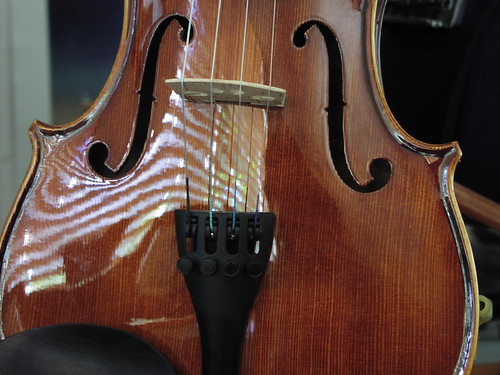
This is a portrait of my violin. I'm working my way through the first book (String Builder series by Applebaum) and am about to get into some more complicated patterns of switching strings. At the last lesson I took, I experienced an interesting synchronicity moment. You can go from one string to another by anchoring off the note you are playing. This means that the fingers behind the one that is holding the string down can shift out from under this note to take up positions for the next note. This is very similar to how you find the correct location for the heel of your hand when doing CPR.
You take your index and middle fingers of your right hand and match your fingers with the bottom edge of the sternum as the patient is lying face up with their head to your left. The right-hand edge of your middle finger is on the edge of the sternum, like you are matching a hem.
Placing your two fingers (which are held together like the pope always seems to be doing in old paintings) you place the heel of your left hand immediately above and to the left of your two right-hand fingers. Move your right hand over the left hand to stack the heels as best you can.
I always watch for CPR in movies and shows because they usually have the responder with very bent arms pretending to apply CPR. Your arms should be straight, perpendicular to the ground, and you should be prepared to apply enough pressure to depress the chest by one-third its depth. That's a lot. With an older patient, you will hear ribs crack. With younger patients, you will hear cartilige complain. Living is the goal, but you don't want to compress too much, either. It's an acquired taste, I guess.
Here is a link to a file you can print out for reference to rescue breathing and CPR.
http://www.rav.vic.gov.au/media/CPRChart.pdf
So this brings up another subject that George and I were talking about. Good Samaritan Laws!
If you are not familiar with the parable of the Good Samaritan, here it is (Luke 10:25-37, NAB).
25
There was a scholar of the law who stood up to test him and said, "Teacher, what must I do to inherit eternal life?"
26
Jesus said to him, "What is written in the law? How do you read it?"
27
He said in reply, "You shall love the Lord, your God, with all your heart, with all your being, with all your strength, and with all your mind, and your neighbor as yourself."
28
He replied to him, "You have answered correctly; do this and you will live."
29
But because he wished to justify himself, he said to Jesus, "And who is my neighbor?"
30
Jesus replied, "A man fell victim to robbers as he went down from Jerusalem to Jericho. They stripped and beat him and went off leaving him half-dead.
31
12 A priest happened to be going down that road, but when he saw him, he passed by on the opposite side.
32
Likewise a Levite came to the place, and when he saw him, he passed by on the opposite side.
33
But a Samaritan traveler who came upon him was moved with compassion at the sight.
34
He approached the victim, poured oil and wine over his wounds and bandaged them. Then he lifted him up on his own animal, took him to an inn and cared for him.
35
The next day he took out two silver coins and gave them to the innkeeper with the instruction, 'Take care of him. If you spend more than what I have given you, I shall repay you on my way back.'
36
Which of these three, in your opinion, was neighbor to the robbers' victim?"
37
He answered, "The one who treated him with mercy." Jesus said to him, "Go and do likewise."
The parable of the Good Samaritan has been used as a model for charity for quite a while. At least two sets of laws have the general name "Good Samaritan Laws."
On October 1, 1996, President Clinton signed the Bill Emerson Good Samaritan Food Donation Act to "encourage the donation of food and grocery products to non-profit organizations for distribution to needy individuals."
Donors are protected from liability when donating to a non-profit. The product had to have been donated in good faith. If the product later causes harm to a recipient, but the item was donated with good intentions, then the donor is protected from liability. It standardized liability for the United States. No longer did large or interstate donors have to research liability laws that might differ across state lines. The standards for negligence and intentional misconduct were articulated. The law also addressed the problem of donating items close to their expiration date. Donating items that are about to be thrown out isn't negligent under the law. The items do need to be used quickly, but the law clarified this issue in favor of donation. Donors are not negligent just because a grocery item is almost out-of-date. The law seeks to encourage donation up to the expiry date. It's up to the recipient organizations to either use or discard, depending on need, organizational efficiency, and how close the expiry date is.
The second body of law, and the sort of law I'm a little more familiar with, is the Good Samaritan laws that protect people rendering first aid to someone in need.
Good Samaritan laws vary from state to state in the U.S. and from province to province in Canada.
Virtually all laws do however have some things in common.
First, you have to be rendering aid to someone that has not refused it. Note that there isn't a requirement of consent. There is the concept of informed consent in rendering medical aid. If a person is conscious and coherent enough to understand and accept help, that's great. However, if someone is unconscious and bleeding to death, a reasonable person would conclude that, if they were awake, they'd accept your help. This is called implied consent and is recognized as medical consent. There are a couple of other interesting consent issues in medical law, but the important idea for Good Samaritan laws is that the person hasn't refused your assistance. If you provide aid after someone has refused it, and the issue of implied consent (victim too drunk to think clearly, has mental illness that prevents reasonable conclusions, was unconscious, etc) doesn't apply, then you have committed assault, and you might be prosecuted for it.
Secondly, you must be volunteering your aid. You cannot ask the victim for payment. If you are a professional that is required to render aid to a victim, then you are not covered by Good Samaritan laws (in general). Good Samaritan laws were written for people volunteering consentual aid in an unpaid manner.
Third, you have to stick around as long as it takes to hand over the patient to someone more qualified, or when it becomes too dangerous for you to remain (fire, landslide, poison gas, don't have latex gloves to protect from disease, can't get the person away from the danger, etc). If you begin to provide assistance, then abandon the patient, you are no longer protected. Leaving to call for help does not constitute abandonment. A responder can never be forced to put him or herself in danger to aid another person.
Fourth, you have to have provided care in a calm and reasonable manner. The legal standard is something like "the responder acted as a calm and rational person of the same level of training would have under the same circumstances".
So, one way of expressing it in plain language would be "Any person who, in good faith, renders emergency medical care or assistance to an injured person at the scene of an accident or other emergency without the expectation of receiving or intending to receive compensation from such injured person for such service, shall not be liable in civil damages for any act or omission, not constituting gross negligence, in the course of such care or assistance."
The law recognizes the difficulty that you face when you try to help someone in need. The law is designed to remove the added burden of worrying about personal liability in the case that the victim suffers or dies.
The spread of AED (automatic external defibrilators) really got the Good Samaritan Laws going in North America. States that already had them updated them. States that didn't have them got them. AEDs are those packs that you see in airports and other public places that have a short, clear instruction set that allows a layperson to defibrillate someone whose heart has stopped. The term defibrillate means that the heart has lost it's rhythmic contractions. To Fibrillate means "Rapid uncoordinated twitching movements that replace the normal rhythmic contraction of the heart and may cause a lack of circulation and pulse." The AED zaps the heart back into rhythm, with luck and early application.
Ontario passed their Good Samaritan Act in 2001.
Ontario Good Samaritan Act Text
http://www.e-laws.gov.on.ca/DBLaws/Statutes/English/01g02_e.htm
**********************************
Good Samaritan Act, 2001
S.O. 2001, CHAPTER 2
No Amendments.
Definition
1. In this Act,
"health care professional" means a member of a College of a health profession set out in Schedule 1 to the Regulated Health Professions Act, 1991. 2001, c. 2, s. 1.
Protection from liability
2. (1) Despite the rules of common law, a person described in subsection (2) who voluntarily and without reasonable expectation of compensation or reward provides the services described in that subsection is not liable for damages that result from the person's negligence in acting or failing to act while providing the services, unless it is established that the damages were caused by the gross negligence of the person. 2001, c. 2, s. 2 (1).
Persons covered
(2) Subsection (1) applies to,
(a) a health care professional who provides emergency health care services or first aid assistance to a person who is ill, injured or unconscious as a result of an accident or other emergency, if the health care professional does not provide the services or assistance at a hospital or other place having appropriate health care facilities and equipment for that purpose; and
(b) an individual, other than a health care professional described in clause (a), who provides emergency first aid assistance to a person who is ill, injured or unconscious as a result of an accident or other emergency, if the individual provides the assistance at the immediate scene of the accident or emergency. 2001, c. 2, s. 2 (2).
Reimbursement of expenses
(3) Reasonable reimbursement that a person receives for expenses that the person reasonably incurs in providing the services described in subsection (2) shall be deemed not to be compensation or reward for the purpose of subsection (1). 2001, c. 2, s. 2 (3).
3. Omitted (provides for coming into force of provisions of this Act). 2001, c. 2, s. 3.
4. Omitted (enacts short title of this Act). 2001, c. 2, s. 4.
**********************************
Here we can introduce the difference between protecting someone from liability, if they meet the conditions of rendering responsible aid, and requiring someone to respond.
The question from a human rights point of view is "Do you have the right to be rescued?"
If a person decides not to render aid, are they committing a crime?
Good Samaritan Laws protect those that choose to help. The Canadian province of Quebec requires people to help someone in need.
From the web: (lost the link, my apologies)
"Quebec is unique in Canada in imposing a duty on everyone to help a person in peril. The duty to take action stems from the Quebec Charter of Human Rights and Freedoms enacted in 1975, and the Civil Code.
The Charter contains a provision that imposes an obligation to render aid if it can be accomplished without serious risk to the good samaritan or a third person. There is still little jurisprudence interpreting these provisions.
Under the Civil Code, every person is obligated to act as a bon pere de famille, broadly defined as a reasonably prudent person. Failure to do so would amount to fault and lead to legal wrong."
The requirement to render aid is authoritarian. Being able to act upon the decision to render aid out of goodwill is libertarian.
The rights of the victim do not outweigh the freedom of the responder. Those reading Paul's Kantian ethics blog entry (found here) about the man with the plank will hopefully see a similarity.
In a libertarian society, the decision to render aid is made without the force of law requiring it. When it is a requirement, it's not charity.
Friday, February 11, 2005
Podcasting Success, and Theory
Broadcast media of the national TV network and print newspaper variety have a very important place within the framework of society. The process of gathering information from daily life, distilling it into an article for print or broadcast, putting those broadcasts on the air, printing and distributing articles, reading the information, and incorporating it into daily life involves billions of people worldwide. Broadcasting brought the world into people’s homes. Now that the world has been there for a while, people are ready to move beyond being passive observers. Many of us are becoming more active participants in a way that will fundamentally change the landscape of journalism.
Journalism is the backbone of politics. Without the freedom to "journal", free speech is meaningless. A free press is the pilot light of democracy. If it goes out it's dark and cold and no one can get anything done. It's almost impossible to go too far in extolling the virtues of having the freedom of speech, freedom of association, freedom of press, and the property rights that allow all of that to happen. Our free press is a fantastic, valuable, almost sacred institution.
So, if the system is really that good, then why is there a revolution brewing?
Thomas Kuhn described, in The Structure of Scientific Revolution, the stair-step progression of scientific knowledge. Great leaps forward in scientific understanding occur (evolution, relativity, string theory). Then, a basing period happens where the revolutionary discoveries are incorporated, refined, cost-reduced, productized, and democratized. Better instrumentation becomes available. New observations are made. A new discovery is reported. Theories are proposed. Debate happens. Great leaps forward occur, and we’re back to the start of the scientific cycle. It just keeps happening, in both large and small loops, all the time.
Refinements in drugs allow treatments of disease that allow certain people to live longer. Better coding schemes allow more people to talk using the same frequency spectrum, allowing more cellular phones to be sold, allowing portable communication to change the way business is done. A different way of recording images is designed, allowing more photographs to be taken, allowing the use of images in daily life to explode. And so on. Galileo’s use of the newly refined instrument called the telescope lead directly to the conceptualization of a completely different type of universe, a universe where going to the moon, the planets, and even other stars is not out of the question.
Now, take Kuhn’s model of scientific revolution and apply it to cultural communications such as journalism.
Technology in the form of the internet, word processing, and widespread connectivity to the internet is the “instrumentation” that allows blogging. This “new telescope” of an instrument was produced from the last cultural revolution in journalism – the rise of the internet itself. The decentralized “brain” of online journalism awakens and takes an active role in current affairs, politics, and opinion. Blogging develops, is refined, and is spread. As more people blog, a basing period for blogging occurs. When a critical mass of people blogging is reached, when those people are connected to the resources they need to write about things, and when they can find each other, they are able to show their strength and begin to effect change. They begin to force a cultural revolution in journalism.
Blogging is to print journalism what podcasting is to broadcast journalism.
Podcasting is an “instrumentation” that was enabled by many of the same things that enabled blogging, with the addition of the portable mp3 player. The iPod, for which podcasting is putatively named, is the device that I have. Any other portable audio player will do. In fact, your PC will suffice. You don’t have to have a portable device to participate. However, the ability to take your audio programs with you anytime you pick up your iPod is extremely powerful. It releases you from your desk.
Is podcasting a killer app for the iPod? Is Podcasting the thing that will make portable digital audio players as universal as email/internet browsers made the personal computer?
It certainly could, since it capitalizes on the very powerful and basic human need of communication. It does it in a way that is really quite easy for both the listener and the speaker.
The old model of a radio personality having fans doesn’t hold up with podcasting. Podcasters view themselves as peers to their listeners, much the same way that bloggers generally view themselves as peers of their readers, who are more like collaborators than passive readers, since the threading of commentary in blogging is what gives it real power.
The word “fan” doesn’t and shouldn’t apply in podcasting, since a fan is subservient to the star. Many podcasters create talk, opinion, and/or news shows that are directly related to the email and phone calls and friends they’ve made through becoming journalists. Podcasters claim a more collaborative, democratic, decentralized, and informal environment than traditional radio personalities and broadcast journalists. This introduces a natural limit that traditional broadcasting faced. Once your audience becomes so large as to be anonymous, the ability to “pedestal”, or introduce a distance between yourself and the listener, is naturally apparent. Therefore, a popular podcaster either “makes it” into broadcasting, where the operating culture can train him or her or them, or the podcaster bogs down and self-limits to a region, city, or neighborhood.
There is a related issue that came to light quite forcefully during “Rathergate”. Bloggers and Podcasters tend to be overwhelmingly amateur. This means that they tend to be self-trained and/or unpaid. Amateur is a word that arises from amore, which means love. Amateurs do things out of love of a hobby rather as a profession. Many amateurs end up getting training and becoming professionals. Many others seek to retain the things that draw them to a hobby or pastime and view professionalization as a potential corruption of their practice.
Rathergate, of course, is the Dan Rather scandal where forged documents concerning President George W. Bush’s service in the National Guard were presented as authentic on CBS broadcasts.
To recap, the blogosphere debunked the documents’ authenticity. There were many instant experts out there that researched typewriters, gave the documents a good going-over, and posted their reports. When intelligent people are motivated, have access to information, and can easily talk to each other, the resolution of a suspected fraud is almost inevitable. You can see this every day on sites like Slashdot. Something motivates us to correct others far more strongly than we’re motivated to confirm our own assumptions. It’s similar to a verbal feeding frenzy.
The key issue for me in Rathergate was the traditional media response. Most famously, the “pajamas quote”.
**************Start Quote
From http://talkleft.com/new_archives/007875.html
Monday :: September 13, 2004
'Pajama Blogging'
Instapundit has been talking about "pajama blogging" which appears to be short-hand for the level of trust one should put in blogger accounts of news as opposed to those of the mainstream media. Glenn says,
JUST CAUGHT Jonathan Klein debating Stephen Hayes about the CBS forgery scandal. Klein says that "Bloggers have no checks and balances . . . [it's] a guy sitting in his living room in his pajamas."
Non- "big media bloggers" may not have censors, bosses or editors, but that per se doesn't make them untrustworthy. As Glenn points out, bloggers use hyperlinks to source their posts--and generally are quick to admit a mistake and correct it. As I wrote in this recent op-ed about convention-blogging in the Denver Post:
Bloggers are not a substitute for the 5 o'clock news. We help complete the picture. We keep the media honest. If the media won't cover the real story, bloggers will. Just remember, a blog is only as credible as its author. With 3.5 million blogs now on the Web, choose carefully. It's read at your own risk.
**************End Quote
It’s a fundamental thing in journalism to authenticate your information. Trained journalists have somewhat of an advantage here. They know, in general, how to handle sources, how to confirm many types of information, and how to fact-check. However, when pressure to outperform your competition, get ratings, and maintain advertisers gets in the mix, attention to detail can suffer. Adding in the temptation to bash an unpopular (in your circle) politician and throwing in the additional assumption that the consumer will consent to being spoon-fed anything you present to them in a broadcast and you will absolutely and inevitably get Rathergate. The responsibility of the blogger and the podcaster is to improve their practice. To take what the traditional journalist does well, and learn from it, and grow their own skillset to enhance their own goals.
We are all quite accustomed to being the passive recipient of broadcasts. This does not under any circumstances mean we prefer it. This does not mean that things like podcasting will fail, simply because of its informality, susceptibility to lack of peer review, and vulnerability to regionalism, extremism, excessive obscenity, or tunnel-vision.
However, I can tell you from personal experience how refreshing it is to hear news, music, and opinion that isn’t bland, dumbed-down, or “cutsie”.
For example, here is the body of a letter I wrote to a popular morning show.
“Katie Couric, you might be a nice woman. You are wealthy, attractive, and I’m sure you have legions of fans. But your performance as a host of the Olympics, the daily pabulum that you pronounce on air, and the anti-intellectualism that you represent, are all revolting to me. I am not entertained by, nor do I watch, your show. When you have to appeal to everyone, you end up being truly appealing to no one.”
Blogging and podcasting, because of their extreme democratization of the presentation of opinion and journalism, suffer from the pitfalls of democratization that is encountered any time that democratization happens. When you broaden the base of participants, the elite are quickly outnumbered. They may lose their elite status in some ways. However, the average ability level of the whole people is raised. And, although it may not feel like it, the elite are better off because everyone is better off and truly great things begin to happen that would not have happened otherwise.
Democratic access to things like education and property enable Kuhn’s scientific revolutions to take place. Since discoveries often come from completely unexpected quarters, democratization of science, speech, and creativity drastically strengthens society. For a fictional example, take the episode of Star Trek The Next Generation where Geordi’s visor played a key role. This visor allows him, a blind man, to see. This visor becomes the key enabling technology for an encountered civilization to avert disaster. The irony is that the encountered civilization has an authoritarian policy on science and society. Blind people do not exist because blindness is bad. Therefore the technology to allow sight for the blind was not developed because they corrected blindness, as well as many other disabilities, as a matter of course. Their society, while advanced, was stagnant. They had cut themselves off from advancement by seeking to define what was advanced.
Big media cannot define itself as advanced. Big, traditional, broadcast media cannot and should not stop blogging, podcasting, or active viewer participation. Progress is occurring at a fundamental level all the time. It’s only on rare occasions that the dramatic tectonic shifts of culture occur. These shifts are enabled by instruments. Instruments of change are now in the hands of a great many people. The change will occur. Don’t get left behind.
There is absolutely and definitely a place for national news. There are shows of compelling national appeal. There is, however, a deep yawning chasm when it comes to regional, neighborhood, or organizational-level journalism.
I remember quite distinctly the movement for micropower FM stations that would serve as an alternative to the large commercial radio stations. The barriers to entry were not completely insurmountable, but widely dispersed micropower FM stations, a la the 1990 movie Pump Up the Volume, require purchase and operation of FM transmitters and significant risk of prosecution and punishment under onerous and pro-establishment regulatory law.
PCs with microphones are the Galilean telescope. Not micropower transmitters. Taking the path of least resistance, it’s an obvious choice. Podcasting sidesteps the FCC and provides an audience that might not be as universal as you like, especially since the poor often have access only to FM receivers, but it’s way better and easier than nothing, and is a superior choice if you want to avoid any risk of running foul of the law.
We’ve allowed broadcasting to largely replace discourse. Podcasting is poised to provide that level of involvement, discussion, debate, and entertainment that a civil society requires and that will take us up to the next step of journalism, debate, and politics. The repercussions of improved civil communications are scary big. Things will happen because the world of journalism is opened up to millions more people. Reading a paper is one thing. Writing one is another. Listening to Howard Stern is one thing. Being better than Howard Stern (and being able to be heard by anyone with internet access) is another.
Learning passively works up to a point. Doing something really opens up the theory through practice.
Here is how it feels to practice what you preach.
I have, for many months now, been recording mass at my church, St. Therese of Carmel Catholic Church, in San Diego, California. What originally was intended to help only the choir to improve, since listening to yourself sing can be quite the motivation for improvement, rapidly transitioned into a ministry of service to those that could not be at mass. Sick, traveling, or otherwise homebound people that would be interested in hearing mass could hear it if it was on the internet. People that, like the person I was only a few years ago, identified as catholic yet were not interested in participating in organized religion, would benefit as well. Another unanticipated benefit was our priest could share his work with his family back in Ireland. This is Kuhn’s cycle of revolution in action. My original goals were met, then greatly exceeded.
Providing the content on the internet was one thing, but podcasting it was another. Providing a link on a webpage required the person wanting to listen to go track down the page, click the link, and either save it or stream it. With podcasting, I could provide a subscription service. I would have to modify my own pages and content only slightly, but it would make it much easier for many people out there to take advantage of it.
By using Blogger and Feedburner websites, and by following a very simple and turnkey method, the content was presented in a way that allowed subscription podcasting to happen, and it took only minutes. The recording, uploading, and posting of content was minimally difficult. I was amazed at how well everything worked, and have to give a special thank-you to Adam Curry and the ipodder.com website for the advocacy of podcasting that is provided by him and so many others.
There are often snags in using technology. Problems occur. But, by and large, podcasting, blogging and mobblogging have been some of the most enjoyable and natural-feeling things I’ve ever done as a citizen of the internet.
Putting church music on the internet may not sound very hip. It’s profoundly retro in the sense that being religious and being active in your church community is a very traditional thing to do. However, podcasting mass is done in the spirit of service, and with 65 million catholics in the United States, you can argue that the market for religious services, discussion, and music is quite large, just within my own faith tradition.
I’d like to close by encouraging each and every one of you to strongly consider subscribing and contributing your opinion to the world. We all strive to be heard, and to hear. We all long for our own definition of immortality. This is a way for you, the intelligent, the honest, the sensitive, the introverted, the ebullient – it’s a way for you to make a difference, leave a mark, affect others, and to be human.
If you need help or encouragement, let me know.
Journalism is the backbone of politics. Without the freedom to "journal", free speech is meaningless. A free press is the pilot light of democracy. If it goes out it's dark and cold and no one can get anything done. It's almost impossible to go too far in extolling the virtues of having the freedom of speech, freedom of association, freedom of press, and the property rights that allow all of that to happen. Our free press is a fantastic, valuable, almost sacred institution.
So, if the system is really that good, then why is there a revolution brewing?
Thomas Kuhn described, in The Structure of Scientific Revolution, the stair-step progression of scientific knowledge. Great leaps forward in scientific understanding occur (evolution, relativity, string theory). Then, a basing period happens where the revolutionary discoveries are incorporated, refined, cost-reduced, productized, and democratized. Better instrumentation becomes available. New observations are made. A new discovery is reported. Theories are proposed. Debate happens. Great leaps forward occur, and we’re back to the start of the scientific cycle. It just keeps happening, in both large and small loops, all the time.
Refinements in drugs allow treatments of disease that allow certain people to live longer. Better coding schemes allow more people to talk using the same frequency spectrum, allowing more cellular phones to be sold, allowing portable communication to change the way business is done. A different way of recording images is designed, allowing more photographs to be taken, allowing the use of images in daily life to explode. And so on. Galileo’s use of the newly refined instrument called the telescope lead directly to the conceptualization of a completely different type of universe, a universe where going to the moon, the planets, and even other stars is not out of the question.
Now, take Kuhn’s model of scientific revolution and apply it to cultural communications such as journalism.
Technology in the form of the internet, word processing, and widespread connectivity to the internet is the “instrumentation” that allows blogging. This “new telescope” of an instrument was produced from the last cultural revolution in journalism – the rise of the internet itself. The decentralized “brain” of online journalism awakens and takes an active role in current affairs, politics, and opinion. Blogging develops, is refined, and is spread. As more people blog, a basing period for blogging occurs. When a critical mass of people blogging is reached, when those people are connected to the resources they need to write about things, and when they can find each other, they are able to show their strength and begin to effect change. They begin to force a cultural revolution in journalism.
Blogging is to print journalism what podcasting is to broadcast journalism.
Podcasting is an “instrumentation” that was enabled by many of the same things that enabled blogging, with the addition of the portable mp3 player. The iPod, for which podcasting is putatively named, is the device that I have. Any other portable audio player will do. In fact, your PC will suffice. You don’t have to have a portable device to participate. However, the ability to take your audio programs with you anytime you pick up your iPod is extremely powerful. It releases you from your desk.
Is podcasting a killer app for the iPod? Is Podcasting the thing that will make portable digital audio players as universal as email/internet browsers made the personal computer?
It certainly could, since it capitalizes on the very powerful and basic human need of communication. It does it in a way that is really quite easy for both the listener and the speaker.
The old model of a radio personality having fans doesn’t hold up with podcasting. Podcasters view themselves as peers to their listeners, much the same way that bloggers generally view themselves as peers of their readers, who are more like collaborators than passive readers, since the threading of commentary in blogging is what gives it real power.
The word “fan” doesn’t and shouldn’t apply in podcasting, since a fan is subservient to the star. Many podcasters create talk, opinion, and/or news shows that are directly related to the email and phone calls and friends they’ve made through becoming journalists. Podcasters claim a more collaborative, democratic, decentralized, and informal environment than traditional radio personalities and broadcast journalists. This introduces a natural limit that traditional broadcasting faced. Once your audience becomes so large as to be anonymous, the ability to “pedestal”, or introduce a distance between yourself and the listener, is naturally apparent. Therefore, a popular podcaster either “makes it” into broadcasting, where the operating culture can train him or her or them, or the podcaster bogs down and self-limits to a region, city, or neighborhood.
There is a related issue that came to light quite forcefully during “Rathergate”. Bloggers and Podcasters tend to be overwhelmingly amateur. This means that they tend to be self-trained and/or unpaid. Amateur is a word that arises from amore, which means love. Amateurs do things out of love of a hobby rather as a profession. Many amateurs end up getting training and becoming professionals. Many others seek to retain the things that draw them to a hobby or pastime and view professionalization as a potential corruption of their practice.
Rathergate, of course, is the Dan Rather scandal where forged documents concerning President George W. Bush’s service in the National Guard were presented as authentic on CBS broadcasts.
To recap, the blogosphere debunked the documents’ authenticity. There were many instant experts out there that researched typewriters, gave the documents a good going-over, and posted their reports. When intelligent people are motivated, have access to information, and can easily talk to each other, the resolution of a suspected fraud is almost inevitable. You can see this every day on sites like Slashdot. Something motivates us to correct others far more strongly than we’re motivated to confirm our own assumptions. It’s similar to a verbal feeding frenzy.
The key issue for me in Rathergate was the traditional media response. Most famously, the “pajamas quote”.
**************Start Quote
From http://talkleft.com/new_archives/007875.html
Monday :: September 13, 2004
'Pajama Blogging'
Instapundit has been talking about "pajama blogging" which appears to be short-hand for the level of trust one should put in blogger accounts of news as opposed to those of the mainstream media. Glenn says,
JUST CAUGHT Jonathan Klein debating Stephen Hayes about the CBS forgery scandal. Klein says that "Bloggers have no checks and balances . . . [it's] a guy sitting in his living room in his pajamas."
Non- "big media bloggers" may not have censors, bosses or editors, but that per se doesn't make them untrustworthy. As Glenn points out, bloggers use hyperlinks to source their posts--and generally are quick to admit a mistake and correct it. As I wrote in this recent op-ed about convention-blogging in the Denver Post:
Bloggers are not a substitute for the 5 o'clock news. We help complete the picture. We keep the media honest. If the media won't cover the real story, bloggers will. Just remember, a blog is only as credible as its author. With 3.5 million blogs now on the Web, choose carefully. It's read at your own risk.
**************End Quote
It’s a fundamental thing in journalism to authenticate your information. Trained journalists have somewhat of an advantage here. They know, in general, how to handle sources, how to confirm many types of information, and how to fact-check. However, when pressure to outperform your competition, get ratings, and maintain advertisers gets in the mix, attention to detail can suffer. Adding in the temptation to bash an unpopular (in your circle) politician and throwing in the additional assumption that the consumer will consent to being spoon-fed anything you present to them in a broadcast and you will absolutely and inevitably get Rathergate. The responsibility of the blogger and the podcaster is to improve their practice. To take what the traditional journalist does well, and learn from it, and grow their own skillset to enhance their own goals.
We are all quite accustomed to being the passive recipient of broadcasts. This does not under any circumstances mean we prefer it. This does not mean that things like podcasting will fail, simply because of its informality, susceptibility to lack of peer review, and vulnerability to regionalism, extremism, excessive obscenity, or tunnel-vision.
However, I can tell you from personal experience how refreshing it is to hear news, music, and opinion that isn’t bland, dumbed-down, or “cutsie”.
For example, here is the body of a letter I wrote to a popular morning show.
“Katie Couric, you might be a nice woman. You are wealthy, attractive, and I’m sure you have legions of fans. But your performance as a host of the Olympics, the daily pabulum that you pronounce on air, and the anti-intellectualism that you represent, are all revolting to me. I am not entertained by, nor do I watch, your show. When you have to appeal to everyone, you end up being truly appealing to no one.”
Blogging and podcasting, because of their extreme democratization of the presentation of opinion and journalism, suffer from the pitfalls of democratization that is encountered any time that democratization happens. When you broaden the base of participants, the elite are quickly outnumbered. They may lose their elite status in some ways. However, the average ability level of the whole people is raised. And, although it may not feel like it, the elite are better off because everyone is better off and truly great things begin to happen that would not have happened otherwise.
Democratic access to things like education and property enable Kuhn’s scientific revolutions to take place. Since discoveries often come from completely unexpected quarters, democratization of science, speech, and creativity drastically strengthens society. For a fictional example, take the episode of Star Trek The Next Generation where Geordi’s visor played a key role. This visor allows him, a blind man, to see. This visor becomes the key enabling technology for an encountered civilization to avert disaster. The irony is that the encountered civilization has an authoritarian policy on science and society. Blind people do not exist because blindness is bad. Therefore the technology to allow sight for the blind was not developed because they corrected blindness, as well as many other disabilities, as a matter of course. Their society, while advanced, was stagnant. They had cut themselves off from advancement by seeking to define what was advanced.
Big media cannot define itself as advanced. Big, traditional, broadcast media cannot and should not stop blogging, podcasting, or active viewer participation. Progress is occurring at a fundamental level all the time. It’s only on rare occasions that the dramatic tectonic shifts of culture occur. These shifts are enabled by instruments. Instruments of change are now in the hands of a great many people. The change will occur. Don’t get left behind.
There is absolutely and definitely a place for national news. There are shows of compelling national appeal. There is, however, a deep yawning chasm when it comes to regional, neighborhood, or organizational-level journalism.
I remember quite distinctly the movement for micropower FM stations that would serve as an alternative to the large commercial radio stations. The barriers to entry were not completely insurmountable, but widely dispersed micropower FM stations, a la the 1990 movie Pump Up the Volume, require purchase and operation of FM transmitters and significant risk of prosecution and punishment under onerous and pro-establishment regulatory law.
PCs with microphones are the Galilean telescope. Not micropower transmitters. Taking the path of least resistance, it’s an obvious choice. Podcasting sidesteps the FCC and provides an audience that might not be as universal as you like, especially since the poor often have access only to FM receivers, but it’s way better and easier than nothing, and is a superior choice if you want to avoid any risk of running foul of the law.
We’ve allowed broadcasting to largely replace discourse. Podcasting is poised to provide that level of involvement, discussion, debate, and entertainment that a civil society requires and that will take us up to the next step of journalism, debate, and politics. The repercussions of improved civil communications are scary big. Things will happen because the world of journalism is opened up to millions more people. Reading a paper is one thing. Writing one is another. Listening to Howard Stern is one thing. Being better than Howard Stern (and being able to be heard by anyone with internet access) is another.
Learning passively works up to a point. Doing something really opens up the theory through practice.
Here is how it feels to practice what you preach.
I have, for many months now, been recording mass at my church, St. Therese of Carmel Catholic Church, in San Diego, California. What originally was intended to help only the choir to improve, since listening to yourself sing can be quite the motivation for improvement, rapidly transitioned into a ministry of service to those that could not be at mass. Sick, traveling, or otherwise homebound people that would be interested in hearing mass could hear it if it was on the internet. People that, like the person I was only a few years ago, identified as catholic yet were not interested in participating in organized religion, would benefit as well. Another unanticipated benefit was our priest could share his work with his family back in Ireland. This is Kuhn’s cycle of revolution in action. My original goals were met, then greatly exceeded.
Providing the content on the internet was one thing, but podcasting it was another. Providing a link on a webpage required the person wanting to listen to go track down the page, click the link, and either save it or stream it. With podcasting, I could provide a subscription service. I would have to modify my own pages and content only slightly, but it would make it much easier for many people out there to take advantage of it.
By using Blogger and Feedburner websites, and by following a very simple and turnkey method, the content was presented in a way that allowed subscription podcasting to happen, and it took only minutes. The recording, uploading, and posting of content was minimally difficult. I was amazed at how well everything worked, and have to give a special thank-you to Adam Curry and the ipodder.com website for the advocacy of podcasting that is provided by him and so many others.
There are often snags in using technology. Problems occur. But, by and large, podcasting, blogging and mobblogging have been some of the most enjoyable and natural-feeling things I’ve ever done as a citizen of the internet.
Putting church music on the internet may not sound very hip. It’s profoundly retro in the sense that being religious and being active in your church community is a very traditional thing to do. However, podcasting mass is done in the spirit of service, and with 65 million catholics in the United States, you can argue that the market for religious services, discussion, and music is quite large, just within my own faith tradition.
I’d like to close by encouraging each and every one of you to strongly consider subscribing and contributing your opinion to the world. We all strive to be heard, and to hear. We all long for our own definition of immortality. This is a way for you, the intelligent, the honest, the sensitive, the introverted, the ebullient – it’s a way for you to make a difference, leave a mark, affect others, and to be human.
If you need help or encouragement, let me know.
Wednesday, February 09, 2005
Monday, February 07, 2005
Podcasting Article
http://www.cnn.com/2005/TECH/ptech/02/07/podcasting.ap/index.html
It's getting some mainstream press. I'm excited about this. There are a lot of very enjoyable and fun podcasts out there. What blogging does for redistribution of power of the written word of journalism, so might podcasting do for the redistribution of the spoken word of broadcasting.
It's getting some mainstream press. I'm excited about this. There are a lot of very enjoyable and fun podcasts out there. What blogging does for redistribution of power of the written word of journalism, so might podcasting do for the redistribution of the spoken word of broadcasting.
Friday, February 04, 2005
Subscribe to:
Comments (Atom)

